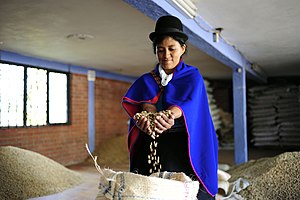コロンビアのコーヒー生産
Coffee production in Colombia/ja

| UNESCO World Heritage Site | |
|---|---|
 | |
| Location | コロンビア |
| Reference | 1121 |
| Inscription | 2011 (35th Session) |
| Area | 141,120 ha (348,700 acres) |
| Buffer zone | 207,000 ha (510,000 acres) |
| Coordinates | 5°28′18″N 75°40′54″W / 5.47167°N 75.68167°WCoordinates: 5°28′18″N 75°40′54″W / 5.47167°N 75.68167°W |
コロンビアのコーヒー生産は、マイルドでバランスの取れたコーヒー豆を生産することで知られている。コロンビアの年間平均コーヒー生産量は1,150万袋で、ブラジル、ベトナムに次ぐ世界第3位であるが、アラビカ豆に限れば世界一です。コロンビア産コーヒー豆は、アメリカ、ドイツ、フランス、日本、イタリアに輸出されている。ほとんどのコーヒーはコロンビアのコーヒー栽培地域で栽培されているが、シエラネバダ・デ・サンタマルタのような他の地域では、量よりも品質に重点を置いている。2007年には、欧州連合がコロンビアコーヒーに原産地名称保護制度を付与した。2011年には、ユネスコがコロンビアの「コーヒー文化景観」を世界遺産に登録した。
コーヒーの木は1790年までにコロンビアに伝播した。コロンビアにおけるコーヒーの存在を示す最も古い書面記録は、イエズス会司祭ホセ・グミラによるものとされている。彼は著書『オリノコ図説』(1730年)の中で、メタ川がオリノコ川に流れ込む付近のサンタ・テレサ・デ・タバヘ伝道所でコーヒーの存在を記録している。さらに、カバレロ・イ・ゴンゴラ大司教兼副王(1787年)がスペイン当局に提出した報告書には、国の北東部、ヒロン(サンタンデール)とムソ(ボヤカ)の近くで作物が栽培されていることが記録されている。
初期の栽培
コーヒーの最初の作付けは、国の東部で行われた。1808年には、ベネズエラとの国境近くにあるククタ港から100袋(各60kg)の生豆が輸出され、最初の商業生産が記録された。フランシスコ・ロメロという名の司祭は、国の北東部地域におけるコーヒー栽培の普及に非常に大きな影響を与えたとされている。サラサール・デ・ラ・パルマスという町の教区民の告解を聞いた後、彼は償いとしてコーヒーの栽培を要求した。コーヒーはサンタンデール県とノルテ・デ・サンタンデール県、クンディナマルカ県、アンティオキア県、そして歴史的にカルダス県として知られる地域に定着した。
輸出
これらの初期の発展にもかかわらず、コロンビアの輸出品としてのコーヒーの確立は19世紀後半まで起こらなかった。当時、世界経済が経験した大拡張により、コロンビアの土地所有者は国際市場に魅力的な機会を見出した。次第に、米国は世界で最も重要なコーヒー消費国となり、一方、ドイツとフランスはヨーロッパで最も重要な市場となった。
挫折
当時のコロンビアの大土地所有者は、国際市場の拡大がもたらす新たな機会をすでに活用しようとしていた。1850年から1857年の間に、コロンビアはタバコとキニーネの輸出が大幅に増加し、その後は皮革と生きた牛の輸出が増加した。これらの農産物輸出における初期の取り組みはあまりにも脆弱であることが判明した。それらは実際には、堅固で多様な輸出基盤を構築しようとする試みというよりも、当時の国際価格の高騰から最大の収益を得ようとする反応的な試みに過ぎなかった。これらのセクターの生産は、それぞれの国際価格の好景気が終わるとともに衰退期に入り、真の産業統合は妨げられた。
19世紀から20世紀への転換期に記録された国際価格の下落により、大規模農園の収益性は急落した。これに加え、新世紀の最初の数年間に起こった千日戦争もまた、主要な土地所有者に悪影響を及ぼし、彼らがプランテーションを良好な状態に維持することを不可能にした。この状況は、これらの生産者がプランテーションをさらに発展させるために多額の対外債務を負っていたという事実と相まって、最終的に彼らを破滅させた。サンタンデールとノルテ・デ・サンタンデールのコーヒー農園は危機に陥り、クンディナマルカとアンティオキアの農園は停滞した。
影響

大規模農園を襲った危機は、コロンビアのコーヒー産業に最も大きな変化の一つをもたらした。1875年以来、サンタンデール県だけでなく、アンティオキア県の一部地域や旧カルダスとして言及される地域でも、小規模コーヒー生産者の数が成長し始めていた。20世紀の最初の数十年間には、国内の内部移住と、主にアンティオキア県、カルダス県、バジェ県、トリマ県北部といった国の中央および西部地域での新たな領土の植民地化に支えられ、農村経済に基づいたコーヒー輸出開発の新しいモデルがすでに確立されていた。この新しいコーヒーモデルの拡大と、大規模農園を襲った危機の両方により、コロンビア西部地域は国内のコーヒー産業発展において主導権を握ることとなった。
This transformation was very favorable for the owners of the small coffee estates that were entering the coffee market. The cultivation of coffee was a very attractive option for local farmers, as it offered the possibility of making permanent and intensive use of the land. Under this productive model of the traditional agriculture, based on the slash and burn method, the land remained unproductive for long periods of time. In contrast, coffee offered the possibility of having an intense agriculture, without major technical requirements and without sacrificing the cultivation of subsistence crops, thus generating the conditions for the expansion of a new coffee culture, dominated by small farms.
20th century

In 1913, Colombia exported 1 million 60-kilo bags of coffee. It rose to 3 million by 1930, 4 million by 1937, 5 million by 1943, and more than 6 million by 1953.
Although this new breed of coffee made of country farmers demonstrated a significant capacity to grow at the margin of current international prices, Colombia did not have a relatively important dynamism in the global market of this product. During the period between 1905 and 1935 the coffee industry in Colombia grew dynamically thanks to the vision and long term politics derived from the creation of the Federación Nacional de Cafeteros de Colombia (National Federation of Coffee Growers of Colombia) in 1927.
The union of local farmers and small producers around the Federation permitted them to confront logistical and commercial difficulties that would not have been possible individually. With time and through the research made at Cenicafé, founded in 1938, and the Federation's agricultural Extension Service, improved cultivation systems. More efficient spatial patterns were developed that permitted the differentiation of the product and supported its quality. Currently the Land of Coffee in Colombia includes all of the mountain ranges and other mountainous regions of the country, and generates income for over 500,000 coffee farming families.
Climate change
While a 2011 New York Times article claimed that regional climate change associated with global warming had caused Colombian coffee production to decline from 12 million 132-pound bags, the standard measure, to 9 million bags between 2006 - 2010, with average temperatures rising 1 degree Celsius between 1980 and 2010, and average precipitation increasing 25 percent in the preceding years, disrupting the specific climatic requirements of the Coffea arabica bean, production of Colombia coffee increased significantly from 2011 to 2018 to 14.2 million bags.
Colombian coffee growing axis
The coffee growing axis (Spanish: Eje Cafetero), also known as the coffee triangle (Spanish: Triángulo del Café) is a part of the Colombian Paisa region. There are three departments in the area: Caldas, Quindío and Risaralda. These departments are among the smallest departments in Colombia with a total combined area of 13,873 km2 (5,356 mi2), about 1.2% of the Colombian territory. The combined population is 2,291,195 (2005 census). In 2011 UNESCO declared the region a World Heritage site.
Marketing
National Federation of Coffee Growers of Colombia
The National Federation of Coffee Growers of Colombia is a non-profit business association, popularly known for its "Juan Valdez" marketing campaign. The federation was founded in 1927 as a business cooperative that promotes the production and exportation of Colombian coffee. It currently represents more than 500,000 producers, most of whom are small family owned farms. The federation supports research and development in the production of coffee through grants to local universities and through federation sponsored research institutes. The federation also monitors production to ensure export quality standards are met. The Federation was founded with three objectives: 1) to protect the industry, 2) to study its problems, and 3) to further its interests. Uribe C., Andrés; Brown Gold, The Amazing Story of Coffee; Random House, Inc., New York, 1954, Pg 113, Library of Congress Catalog Card Number 55-5793</ref> The Juan Valdez branding concept was developed in 1981 to distinguish 100% Colombian coffee from coffee blended with beans from other countries. The trademark made its first TV appearance in 1983 featuring a country farmer carrying coffee on his mule.
Juan Valdez
National Coffee Park
Parque del Café (Coffee Park) is a theme park in the department of Quindío, Colombia, 4 km south-west of the town of Montenegro and 11 km west of the departmental capital city Armenia. The park was founded by the National Federation of Coffee Growers of Colombia (La Federación Nacional de Cafeteros de Colombia) and the Departmental Committee of Coffee Growers of Quindío (El Comité Departamental de Cafeteros del Quindío), and opened on 24 February 1995. It consists of two main areas: by the main entrance are the buildings housing the museum and exhibitions detailing the history, culture and process of growing and producing coffee in the region; and in the valley beyond is an amusement park with rides and shows. The two areas are linked by two gondola lifts and a chairlift: it is also possible to walk between the two areas via an ecological trail that passes through a plantation of many varieties of coffee bushes.

External links
 Media related to Coffee in Colombia at Wikimedia Commons
Media related to Coffee in Colombia at Wikimedia Commons- Coffee Cultural Landscape of Colombia, UNESCO, unesco.org
- Coffee production in Sierra Nevada de Santa Marta.
| この記事は、クリエイティブ・コモンズ・表示・継承ライセンス3.0のもとで公表されたウィキペディアの項目Coffee production in Colombia/ja(26 May 2025, at 05:03編集記事参照)を素材として二次利用しています。 Lua error in Module:Itemnumber at line 91: attempt to concatenate local 'qid' (a nil value). |
